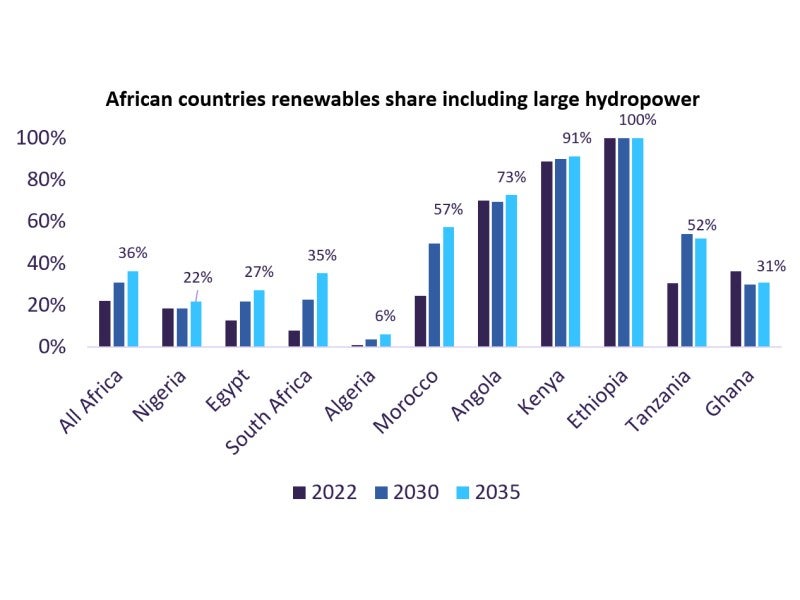In November 2022, Egypt hosted the United Nations Climate Conference, more commonly known as COP27. The conference spotlighted the uneven impact of climate change and the disparity between countries that contribute large volumes of carbon emissions and those that face the worst impacts of climate change. The International Energy Agency’s (IEA) Africa Energy Outlook 2022 report revealed that despite holding one-fifth of the world’s population, African countries are responsible for less than 3% of energy-related carbon dioxide emissions to date. In addition, countries across Africa account for some of the lowest per capita emissions in the world.
The IEA report also revealed that 43% of the continent’s population lack access to electricity, mostly in Sub-Saharan Africa. Fulfilling the region’s energy demand while enabling a socially just and low-carbon form of development will be a key challenge for the region. This challenge will also intensify as population growth increases overall energy demand, with the 2022 UN World Population Prospects report predicting that Sub-Saharan Africa will become the world’s most populous region in the late 2060s.
However, in addition to posing a challenge, the need for a global energy transition may still prove an opportunity for the region. The continent has some of the greatest potential for renewable energy in the world, with favourable climatic conditions for solar and wind farms. As a result, countries such as Kenya have largely clean energy mixes, relying on thermal power for just 11% of their energy demand. Furthermore, other countries across the region have set bold renewable energy targets. For example, Namibia aims to source 70% of its energy demand from renewables in 2030. Meanwhile, South Africa is aiming for 41% renewable generation in the same time frame.

While these policies are being rolled out at a high level, a number of companies are capitalising on the renewable opportunity on the ground. GlobalData’s recent Energy Transition in Africa report forecasts that renewable generation will exceed 460,000GWh in 2035, increasing at a CAGR of 7% each year from 2022. Companies such as Xlinks have emerged as major players in Africa’s renewable energy market, with 7,000MW of capacity for solar power and 3,500MW of capacity for wind power in the pipeline.
The significant potential for renewable energy generation will also create an opportunity for other energy transition technologies. For example, when used in combination with renewable energy, hydrogen fuel cells generate no carbon emissions. Additionally, large deposits of platinum can be found across sub-Saharan Africa, with South Africa accounting for 75% of global production in 2022. Platinum is used to obtain iridium, which forms an expensive but vital part of polymer electrolyte membrane (PEM) electrolysers. As a result, many African countries are strongly positioned to become green hydrogen production hubs. In a bid to make this a reality, countries such as South Africa, Mauritania and Egypt have rolled out national hydrogen strategies and have several hydrogen plants in the pipeline.
In addition to platinum, African countries also have substantial reserves of cobalt, manganese and moderate amounts of lithium, which are vital transition metals for batteries. This means that the continent may come to play a vital role in both the energy storage and electric vehicle (EV) market. According to GlobalData, battery EVs are forecast to capture 44% of the global light vehicle market by 2026, with demand for key metals expected to outstrip supply, creating a significant opportunity for African economies. The rising popularity of EVs will also propel the electrification of domestic transport in African countries as EVs become more affordable as well as EVs increasingly entering the second-hand car market.

US Tariffs are shifting - will you react or anticipate?
Don’t let policy changes catch you off guard. Stay proactive with real-time data and expert analysis.
By GlobalDataAlthough the availability of charging infrastructure is currently slowing adoption, several start-ups have made strides towards electrifying transport across the region through micro-mobility and public transport solutions. For example, the Swedish-Kenyan company, Roam, designs, develops and manufactures its own EVs and charging solutions. These range from motorcycles, public transport buses and commercial vehicles. Kenya’s high proportion of renewable energy caused Roam to identify the country as its key market. However, it has motorcycle pilot projects in six other African countries. Roam has also reached a partnership with Uber to supply another 3,000 electric motorcycles across Africa.
Clearly, the African continent is set to host much more than a climate conference in the future, holding substantial potential for both renewable energy and hydrogen production across its countries. In addition, its transition metal reserves will give African economies a place of prominence within global energy storage supply chains as demand for transition metals continues to outpace supply. As a result of these factors, African countries can be expected to be key players in the world’s energy transition.




